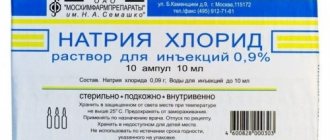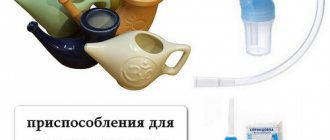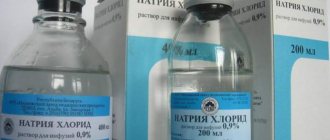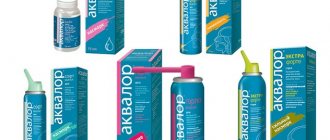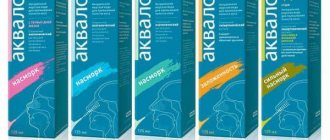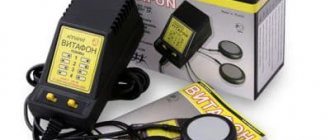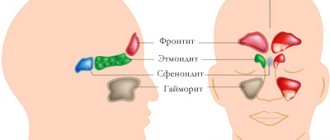How does the drug work on a sore nose?
Using saline solution is a great way to get rid of the unpleasant symptoms of rhinitis without much expense and in a short time. Another name for the drug is sodium chloride. It is often used in medicine due to its ability to quickly balance the water-salt balance.
Saline solution for a runny nose demonstrates its therapeutic effect thanks to the salt molecules included in the composition. Once on the mucous membrane of the nasal passages, sodium chloride triggers the following processes:
- increased mucus production and sputum removal;
- destruction of pathogenic microflora;
- relieving inflammation.
The listed effects significantly alleviate the condition of adults and children. Considering that the composition is practically safe, we can conclude that treating a runny nose with saline will speed up recovery.
If within several days of use the symptoms of rhinitis do not subside, but progress, then examination and serious therapy cannot be avoided.
Is it possible to rinse the nose for pregnant women?
Not only is it possible, but it is necessary! Nasal rinsing is an excellent prevention of colds and associated complications such as sinusitis. This method is very relevant for pregnant women and young children, especially after visiting places with large concentrations of sick people - including clinics and antenatal clinics. What could be easier than returning home from the “hotbed of infections” and rinsing your nose several times with a banal saline solution? Removing mucus from the respiratory tract with microbes accumulated in it increases the chances of not getting sick significantly .
There are several other aggravating factors that lead to some problems with nasal breathing in pregnant women.
- Every pregnant woman, to one degree or another, experiences the phenomenon of so-called vasomotor rhinitis, that is, a runny nose caused by pathological regulation of vascular tone. Some people experience such a runny nose in the first trimester of pregnancy, while others find it annoying on the eve of childbirth. Nasal irrigation helps normalize vascular tone, helps remove nasal congestion and facilitate nasal breathing.
- Many pregnant women, especially in the third trimester, experience constant nasal congestion due to general fluid retention and tissue swelling. Some expectant mothers have such impaired nasal breathing that they have to regularly use vasoconstrictor drops. The situation is significantly aggravated by dry and warm indoor air, as well as by a sedentary lifestyle and lack of walks in the fresh air. Rinsing the nose helps to partially remove swelling of the nasal passages, moisturize the mucous membranes and make breathing easier. It is especially good to ventilate and moisten the room after irrigating your nose, or better yet, go for a walk.
How to properly prepare saline solution
You can purchase a ready-made product at the pharmacy, but homemade saline solution is also perfect because it has the same properties. The technology is simple and involves the following steps:
- Take a liter of boiled water.
- Add a teaspoon of sodium chloride (table salt) to it. It will be even better if you use sea salt instead of regular salt.
- Add a little baking soda.
- Stir the liquid thoroughly until the components are completely dissolved.
Indications and contraindications for the use of saline solution
As mentioned above, rinsing the nose with a saline solution is not harmful to health. The beneficial effects of the product are due to its natural and effective composition. As a result, the runny nose recedes quickly, and discomfort is completely absent. The solution helps relieve nasal congestion caused by a cold or allergic reaction. In this case, the nasal passages are completely disinfected, and there is no risk of developing re-congestion. Finally, salt is the best way to strengthen capillaries and mucosal walls.
People whose work requires constant contact with dust can use the solution to cleanse the nasal passages of dangerous microparticles. This effect will help avoid inflammatory processes. Using a saline solution during pregnancy is one of the safest ways to treat a cold. When using it, any risk to the mother or child is completely eliminated. A similar statement does not apply to vasoconstrictors and nasal drops.
Despite so many positive reviews and recommendations, not everyone can use saline solution. It is not advisable to use this method if you have:
- constant nosebleeds;
- acute otitis;
- obstruction of the nasal passages;
- neoplasms in the nose;
- sensitivity to the components of the solution.
Nasal rinsing is a simple but at the same time effective procedure. Just a couple of manipulations will improve a person’s overall well-being.
Return to contents
Therapy in children
Treatment of a runny nose with saline in children is indicated when the mucus from the nose is too thick and crusts appear. For therapy to be effective, you need to pay attention to the temperature of the saline solution. For babies, you cannot heat it above 37 degrees.
To enhance the effect of a runny nose in children, you can add a little essential oil to the prepared composition. But we must take into account that there is a risk of developing allergies, so before use you should make sure that this does not happen.
It is recommended to drip into the nose and use the rinse regularly; a one-time procedure will not produce the expected result. Doctors allow the use of saline solution for infants, but with some reservations.
Children under one year old are strictly prohibited from rinsing with saline solutions and inhalation; there is a high risk of infection entering the auditory tube.
Infants can use the product only for instillation into the nose. But we must take into account that in case of physiological runny nose, which often occurs in newborns, there is no need to use the drug.
If rhinitis is caused by a cold, then two drops can be administered daily into each nostril up to 3-4 times a day. In case of severe drying out or the formation of dried crusts, saline solution can be instilled into the baby’s nose up to 6 times.
It is advisable to use a solution for the common cold in children from the first manifestations of the disease. There is no need to be afraid of an overdose; it is practically excluded due to the safety of the composition.
Benefits of the procedure
Rinsing the nasal mucosa with saline solution has a number of advantages, including:
- Removal and cleansing of mucous membranes from viruses, bacteria and allergens.
- Rapid restoration of nasal breathing.
- Strengthening the capillaries in the nasal cavity.
- Increasing local immunity.
- Safety.
- Availability.
- Disinfection of the nasopharynx.
- Does not affect the fetus or the course of pregnancy.
- Can be performed in any trimester.
- Ideally combined with other methods of treating rhinitis.
It is recommended to carry out the rinsing procedure not only in case of colds and runny nose, but also in case of chronic diseases of the ENT organs: sinusitis, sinusitis, vasomotor rhinitis. When this procedure is carried out regularly, the risk of complications is greatly reduced.
Carrying out inhalations
To cure annoying rhinitis, you can practice saline inhalation.
It makes no sense to use the drug for steam inhalation. The procedure will not give a positive result, because the salt does not have the ability to evaporate and will not settle on the mucous membranes.
A nebulizer is perfect for this. The device is capable of turning the drug into an aerosol cloud. Particles of the medicinal substance fall on the mucous membranes and penetrate into remote areas. The effectiveness of therapy increases. Inhalation of the solution makes the mucous membrane softer, dilutes sputum and promotes its removal.
Saline solution is allowed to be combined with certain medications for use in the device. Inhalations in children under 6 years of age can be performed up to 3-4 times a day for 3 minutes. For older children, the duration is increased to 5 minutes and the frequency is increased to 4 times.
Why does a runny nose appear during pregnancy?
Almost every pregnant woman has a runny nose. This happens because the situation itself increases the risk of developing acute respiratory infections. Immunity during pregnancy deteriorates, making a woman susceptible to airborne pathogens. Also, reasons why an expectant mother may get sick include:
- Changes in hormonal levels.
Due to increasing hormonal changes and increased production of estrogen and progesterone, swelling of the nasal cavity occurs, and the woman complains of congestion.
- Drying of the mucous membrane.
This is facilitated by an increase in the amount of blood in the body or insufficient air humidity in the room where the woman is most often located, or the presence of allergens there. - Chronic diseases of the nasopharynx diagnosed before conception - deviated nasal septum, adenoids, sinusitis.
These conditions worsen during pregnancy, so it is important to obtain recommendations from an otolaryngologist at the planning stage.
Isotonic sodium chloride solution
Saline solution is a multifunctional drug widely used in all areas of medicine. It is table salt with high antibacterial and healing properties that help strengthen the immune system and have a beneficial effect on human health in general. The medicine is actively used for treating wounds, douching, and diluting medications. How to cure a runny nose at home quickly?
When you have a runny nose, the benefits of saline solution are invaluable. The liquid is excellent for both children and adults, can be used for the prevention and treatment of nasopharyngeal diseases during pregnancy, lactation, diabetes, and other diseases, has an affordable price and practically does not cause side effects. Saline solution is not prohibited from being used even when treating infants and newborns.
A 0.9% sodium chloride solution includes the following main components:
- table salt (NaCl);
- distilled water.
Their ratio in the preparation is as follows: for 9 grams of salt there is 1 liter of water. Analogs of saline solution are drugs such as:
- Aquamaster spray;
- Nazol aqua;
- Aquamaris,
- Aqualor;
- Rizosin;
- Salin;
- sea water.
The listed products are convenient, safe, sterile, have a small dosage, and are sold in bottles equipped with special pipettes or dispensers for convenient use. In terms of their therapeutic effect, they are completely identical to 0.9% sodium chloride solution. Their only drawback is their higher price.
The main advantages of saline solution for rinsing the nose:
- Economic benefit. Regardless of whether you buy a nasal rinse or prepare it yourself at home, its cost is the lowest compared to well-known analogues, which are sold in the form of sprays, drops, etc.
- Simplicity, ease of use. Rinsing the nose with a 0.9% sodium chloride solution is simple and quick, the procedure does not cause discomfort in either a child or an adult, the liquid does not irritate the nasal mucosa, it is recommended to use it for inhalation - this is another significant plus for versatility.
- Possibility of use for treatment and prevention. Saline solution for rinsing the nose is relevant during epidemiological outbreaks of influenza and other viral diseases. The product not only neutralizes the action of bacteria, but also prevents their reproduction.
- Highly effective method for treating and relieving runny nose in patients of different age groups. After the procedure, the nose of both the baby and the adult breathes normally.
- Ease of preparation. To make a nasal rinse solution at home, you do not need to have a medical education.
Contraindications for the use of saline solution for rinsing the nose:
- renal dysfunction;
- cardiovascular failure;
- high or low blood pressure;
- individual intolerance to table salt.
Washing methods
Your doctor should explain how to rinse your nose correctly. First you need to decide on the choice of vessel for introducing the solution. There are several devices used for this purpose. These include a special rinsing kettle, a syringe, a syringe and a nebulizer. The procedure can also be carried out using a pipette, but this is more applicable for pediatric patients.
A special teapot is an invention for rinsing the nasal cavity, which is used by yogis. It is a vessel that holds a sufficient amount of liquid. You can store ready-made herbal decoctions and other rinsing solutions in it. The device resembles an ordinary teapot with a long spout and a comfortable handle. The advantage of this invention is the ability to control the water pressure yourself.
Common objects used for washing are a syringe and a syringe. They are accessible and easy to use. The syringe is sold at any pharmacy. It is shaped like a pear with a long narrow hole. The method of its use is based on drawing in liquid under pressure and releasing the solution under pressure into the nasal cavity. A similar device is an ordinary syringe without a needle.
Rinsing the nasal cavity with a kettle
If your runny nose has just begun, but the mucus is thick, you can use a pipette. With its help, the medicinal solution is fed into the nasal passages gradually. Therefore, the discomfort is minimal. It is not necessary to prepare the rinsing solution yourself; there are many medications available at the pharmacy that are used for this procedure. Most of them are sold complete with a sprayer.
Preparation of the solution
The main advantage of the product is the ability to prepare it at home. However, this is not the only reason why rinsing is particularly popular. The solution is really effective and much better than many pharmaceutical medications. To prepare it, you can use both table and sea salt. Preference should be given to the last component.
So, we prepare a solution based on sea salt. To prepare the product, you need to dissolve 1 tsp. main ingredient in 2 cups of boiled water. It is advisable to filter the liquid before use. You can immediately prepare a larger amount of the product by dissolving 2 tsp. salt in 1 liter of water. The nasal sinuses are washed with the resulting medicine. In some cases, a hyperconcentrated solution is used. To prepare it, you need to dissolve 2 tsp. salt in 1 glass of water. It is advisable to use this remedy for constant contamination of the nasal passages. However, in this case, the risk of severe drying out of the mucous membranes remains.
A solution based on table salt is prepared a little differently. Here it is necessary to adhere to slightly different proportions. To make your nose breathe faster, you should dissolve 1 tsp. salt in 500 ml of liquid. A few drops of iodine will help enhance the effect, because... it has a pronounced anti-inflammatory and disinfectant effect.
You can clean your nasal passages using a soda-salt solution. To prepare it, you should take 0.5 tsp. each of the ingredients and dissolve in a glass of water.
It is recommended to consult a doctor before using any product.
Rinsing the nasal cavities helps to avoid congestion and mucus accumulation. But why is it especially important for pregnant women to always keep their nasal passages clear?
Breathing through the nose is the main type of respiratory activity, which is normally characteristic of all healthy people. When the nasal passages are blocked, breathing is difficult, and therefore less oxygen enters the blood than usual. There is nothing good in this for an ordinary person, but in a pregnant woman this situation can directly lead to chronic fetal hypoxia. This is the name given to the constant lack of oxygen reaching the fetus through the umbilical cord along with maternal blood. In the acute phase, this disorder can lead to miscarriage, and in the chronic phase, it can cause delays and disruption of the child’s intrauterine development.
Nasal rinsing during pregnancy is a great way to avoid this situation. It will also help you prevent infections that can also pose a threat to the fetus.
Causes and symptoms of a runny nose in pregnant women
A runny nose is an inflammation of the nasal mucosa
Rhinitis or runny nose in pregnant women is a common occurrence not only during colds. A runny nose can also appear for other reasons.
There are 3 types of rhinitis:
- Infectious. A runny nose of an infectious nature appears with a cold or respiratory diseases. This symptom occurs more often during pregnancy due to weakened immunity, as the body is more vulnerable to various infections and bacteria.
- Allergic. Rhinitis can occur due to an allergic reaction. An allergic rhinitis occurs when irritating substances enter the respiratory tract. The following irritating agents can be: wool, pollen, dust, medicines, household chemicals, etc.
- Hormone. During pregnancy, the body undergoes major hormonal changes. Under the influence of hormonal changes, a runny nose develops. Congestion is caused by increased levels of estrogen hormones. Hormonal rhinitis in pregnant women usually occurs in the second trimester and continues until childbirth. In this case, nasal congestion without mucous discharge, dryness and itching in the nasal cavity are observed. Hormonal rhinitis does not require treatment and will go away on its own.
The following symptoms are typical for viral and allergic rhinitis:
- copious mucus discharge
- labored breathing
- nasal congestion
- facial swelling
As the infection spreads, severe swelling appears, the temperature rises, and drops do not help relieve nasal congestion. These are dangerous symptoms that require immediate treatment.
Is a runny nose in pregnant women dangerous for the fetus?
Incorrect treatment or severe runny nose can cause complications not only in the pregnant woman, but also in the fetus
A short-term runny nose does not pose a threat to a child if it is not accompanied by high fever and general intoxication of the body. If the snot turns green or yellow, this indicates a bacterial infection, which can be dangerous in the early stages of pregnancy.
A prolonged runny nose leads to breathing problems and can provoke hypoxia - oxygen starvation in the fetus. As a result, there is a delay in the development of the embryo. Rhinitis poses a great danger precisely in the first trimester, when the formation and formation of the baby’s vital organs occurs.
When using vasoconstrictor drugs, there is a high probability of developing placental vascular insufficiency and, as a result, impaired development of the nervous system.
The danger of an allergic rhinitis is that allergens can reach the fetus and cause a reaction in its own immune system. In the later stages, the body prepares for childbirth, so viral or bacterial rhinitis can cause aging of the placenta, the virus entering the amniotic fluid and the development of disease in the fetus or premature birth.
A prolonged runny nose can settle into the respiratory tract, lead to bronchitis or become chronic. Then you will need serious and long-term treatment. To avoid unpleasant consequences, treatment of a runny nose should begin at the first symptoms. It is important to consult a doctor in time and follow all his recommendations. Self-treatment is unacceptable.
Useful video - How to treat a runny nose during pregnancy at home:
To avoid a runny nose, it is recommended to adhere to preventive measures:
- Avoid hypothermia.
- Eat more vegetables and fruits.
- You should drink more fluid. It is useful to take herbal infusions, teas, milk with honey, etc.
- Limit contact with sick people.
- If possible, eliminate salt from your diet. It provokes swelling.
- Eat garlic and onions. They have bactericidal properties. They can also be cut and placed throughout the room.
- It is important to regularly carry out wet cleaning and ventilate the room.
- In good weather, it is recommended to spend a sufficient amount of time outside.
- In the autumn-winter period, it is recommended to use vitamin-mineral complexes. Medicines should only be prescribed by a doctor.
By following these recommendations, you will be able to prevent the occurrence of colds and the symptoms that accompany them.
